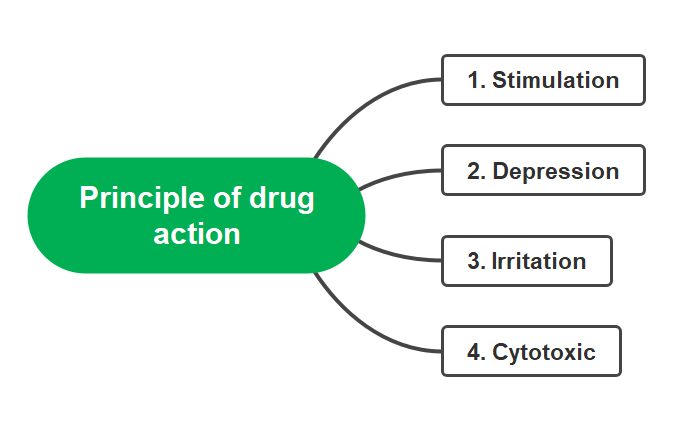Table of Contents
Principle of drug action
Any drug cannot produce any new type of response in our body but it can only stimulate or depressed the action of any organ.

1. Stimulation
When any drug produces any response for the excitatory to any organ, this is called stimulation. When any drug shows less response on their efficiency of work is reduce or they become depress that time is stimulation is required. Example – adrenaline increase the heart beat and caffeine stimulate the CNS.
2. Depression
Depression is a serious mental health disorder that affects millions of people around the world. It can cause debilitating symptoms such as feelings of helplessness, sadness, and low self-esteem. There are also some drugs, which has both properties (stimulate one activity & depress another).
3. Irritation
This is non-selective, often harmful effect and especially applicable to less a specific cells. When any drug bind with the receptor or any organ and produce any inflammatory response or inflammation, this is called irritation. Example- plant bitter increase saliva secretion.
4. Replacement
When our body fail to produce their original response by secreting chemicals, hormones and enzymes, then some other drugs are given to replace that hormones and enzyme and it produced new response, this is called replacement.
5. Cytotoxic
Cytotoxic action is the action in which drug kill the cell which creating disease in human body. For example, antibiotics skill the sale of bacteria virus and protozoa show it help in recovery for disease.
Pharmacodynamics
The pharmacodynamics is the second part of pharmacology, which is the derived from two word pharmacodynamics. The term Pharmaco means ‘drugs’ and dynamics means ‘motion’ or ‘effect’. It means the drug which produce the different action inside the body, this is pharmacodynamics. Pharmacodynamics decide what does to the body. The term pharmacodynamics means the study of mode of action of any drug & biochemical & physiochemical changes which is occurs by the drug it is also study under the pharmacodynamics.
Site of action
The site of action of any drug is defined as those particular organ or tissue where drug so their action and produce some effect. Sometime two different drugs can produce the same response about their site of action may be different. For example – pilocarpine and morphine both the drug shows meiosis in eye but a pilocarpine binds with the circular muscle and morphine bind with the third cranial nerves.
Types of sites of action
1. Extracellular
When the drug shows their action and response in extracellular fluid outside the surface of the cell, then this is called extracellular site. For example, antacid drug neutralized the acidity in inside the stomach which is the extracellular.
2. Cellular
Those drugs which bind on the receptor on the surface of cell membrane they are called cellular site. For example – acetylcholine, adrenaline, pilocarpine. They are bind with the receptor on the present on the surface of the cell and they produce the response.
3. Intracellular
When the drug crosses the cell membrane and goes inside the intracellular fluid and produce response inside the cell organelles and produce the action on cell organelles, they are called intracellular site. For example, Sulfonamides drugs cross the cell membrane and inside the cell membrane, they inhibit the formation of folic acid. So the bacteria are kill, this is called intracellular site.
Mechanism of drug action
How any drugs produce their effect or action is known as mechanism of action. There are only some drugs which produce their effect/action by virtue of their simple physical or chemical properties. Ex- laxatives, antacid(neutralization of gastric HCl).
Most of the drugs produce their effect(action) by interacting with a target biomolecules (proteins).
1. Enzymes
2. Ion channels
3. Transporters
4. Receptors
1. Enzymes
Almost all biological reactions are carried out under catalytic influences of enzymes. So, when drug interact with enzymes it can either increase or decrease the rate of enzyme activity and also the biological activity. When drug bind with enzymes and increase its activity is known as enzyme induction. When any drug decrease the activity of enzyme is known as enzyme inhibitors.
2. Ion channels
Their are many ion channels in our body which helps transmembrane signaling and regulate intracellular ionic composition. Drugs can affect ion channels. Drugs can also affect ion movement by directly binding on channel. Some channels are receptors and drugs also affect these channels.
3. Transporters
Several substrates are move across membrane by binding to specific transporter (through facilitate diffusion). Many drugs affect this, they interact solute carrier and inhibit the movement of metabolite. Example – Amphetamines selectively block dopamine reuptake in brain neurons by dopamine transporter.
4. Receptor
Drug receptors are special proteins located on the surface of cells that interact with drugs and other chemicals. They play an important role in the body’s response to drugs and can determine whether a drug will have its intended effect.


Dear mimprovement.com administrator, Your posts are always well thought out.